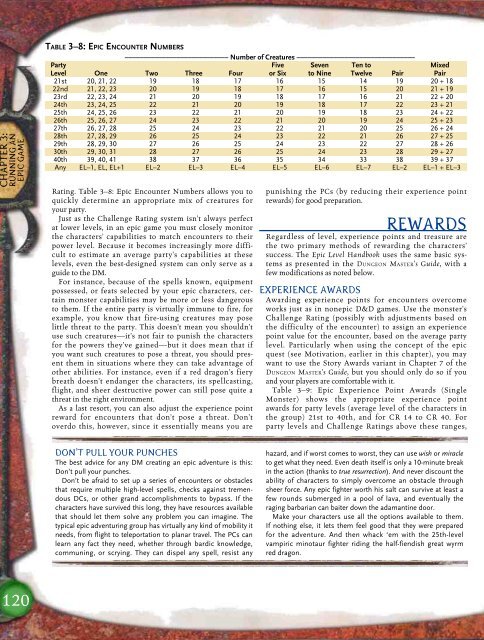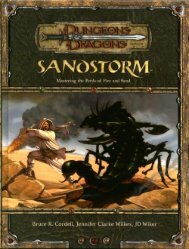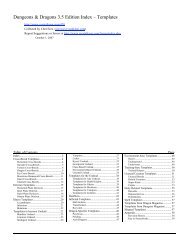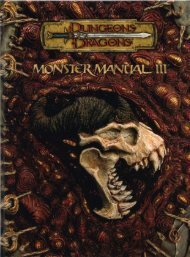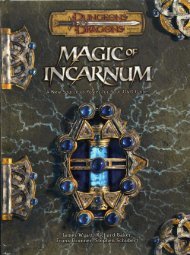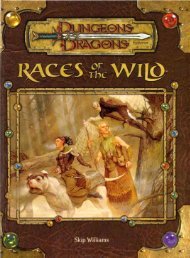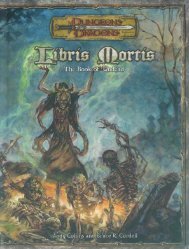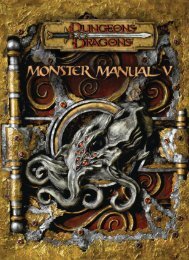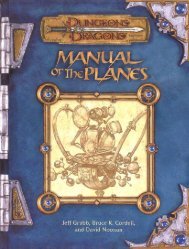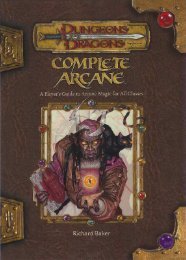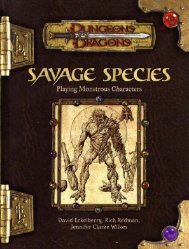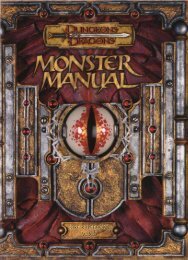CHAPTER 3:RUNNING ANEPIC GAMETABLE 3–8: EPIC ENCOUNTER NUMBERS–––––––––––––––––––––––––––– Number of Creatures ––––––––––––––––––––––––––––––––Party<strong>Level</strong> One Two Three FourFiveor SixSevento NineTen toTwelve PairMixedPair21st 20, 21, 22 19 18 17 16 15 14 19 20 + 1822nd 21, 22, 23 20 19 18 17 16 15 20 21 + 1923rd 22, 23, 24 21 20 19 18 17 16 21 22 + 2024th 23, 24, 25 22 21 20 19 18 17 22 23 + 2125th 24, 25, 26 23 22 21 20 19 18 23 24 + 2226th 25, 26, 27 24 23 22 21 20 19 24 25 + 2327th 26, 27, 28 25 24 23 22 21 20 25 26 + 2428th 27, 28, 29 26 25 24 23 22 21 26 27 + 2529th 28, 29, 30 27 26 25 24 23 22 27 28 + 2630th 29, 30, 31 28 27 26 25 24 23 28 29 + 2740th 39, 40, 41 38 37 36 35 34 33 38 39 + 37Any EL–1, EL, EL+1 EL–2 EL–3 EL–4 EL–5 EL–6 EL–7 EL–2 EL–1 + EL–3Rating. Table 3–8: <strong>Epic</strong> Encounter Numbers allows you toquickly determine an appropriate mix of creatures foryour party.Just as the Challenge Rating system isn’t always perfectat lower levels, in an epic game you must closely monitorthe characters’ capabilities to match encounters to theirpower level. Because it becomes increasingly more difficultto estimate an average party’s capabilities at theselevels, even the best-designed system can only serve as aguide to the DM.For instance, because of the spells known, equipmentpossessed, or feats selected by your epic characters, certainmonster capabilities may be more or less dangerousto them. If the entire party is virtually immune to fire, forexample, you know that fire-using creatures may poselittle threat to the party. This doesn’t mean you shouldn’tuse such creatures—it’s not fair to punish the charactersfor the powers they’ve gained—but it does mean that ifyou want such creatures to pose a threat, you should presentthem in situations where they can take advantage ofother abilities. For instance, even if a red dragon’s fierybreath doesn’t endanger the characters, its spellcasting,flight, and sheer destructive power can still pose quite athreat in the right environment.As a last resort, you can also adjust the experience pointreward for encounters that don’t pose a threat. Don’toverdo this, however, since it essentially means you arepunishing the PCs (by reducing their experience pointrewards) for good preparation.REWARDSRegardless of level, experience points and treasure arethe two primary methods of rewarding the characters’success. The <strong>Epic</strong> <strong>Level</strong> <strong>Handbook</strong> uses the same basic systemsas presented in the DUNGEON MASTER’s Guide, with afew modifications as noted below.EXPERIENCE AWARDSAwarding experience points for encounters overcomeworks just as in nonepic D&D games. Use the monster’sChallenge Rating (possibly with adjustments based onthe difficulty of the encounter) to assign an experiencepoint value for the encounter, based on the average partylevel. Particularly when using the concept of the epicquest (see Motivation, earlier in this chapter), you maywant to use the Story Awards variant in Chapter 7 of theDUNGEON MASTER’s Guide, but you should only do so if youand your players are comfortable with it.Table 3–9: <strong>Epic</strong> Experience Point Awards (SingleMonster) shows the appropriate experience pointawards for party levels (average level of the characters inthe group) 21st to 40th, and for CR 14 to CR 40. Forparty levels and Challenge Ratings above these ranges,DON’T PULL YOUR PUNCHESThe best advice for any DM creating an epic adventure is this:Don’t pull your punches.Don’t be afraid to set up a series of encounters or obstaclesthat require multiple high-level spells, checks against tremendousDCs, or other grand accomplishments to bypass. If thecharacters have survived this long, they have resources availablethat should let them solve any problem you can imagine. Thetypical epic adventuring group has virtually any kind of mobility itneeds, from flight to teleportation to planar travel. The PCs canlearn any fact they need, whether through bardic knowledge,communing, or scrying. They can dispel any spell, resist anyhazard, and if worst comes to worst, they can use wish or miracleto get what they need. Even death itself is only a 10-minute breakin the action (thanks to true resurrection). And never discount theability of characters to simply overcome an obstacle throughsheer force. Any epic fighter worth his salt can survive at least afew rounds submerged in a pool of lava, and eventually theraging barbarian can baiter down the adamantine door.Make your characters use all the options available to them.If nothing else, it lets them feel good that they were preparedfor the adventure. And then whack ‘em with the 25th-levelvampiric minotaur fighter riding the half-fiendish great wyrmred dragon.120
TABLE 3–9: EPIC EXPERIENCE POINT AWARDS (SINGLE MONSTER)Party –––––––––––––––––––––––––––––––––––––––––––––––––– Challenge Rating ––––––––––––––––––––––––––––––––––––––<strong>Level</strong> CR 14 CR 15 CR 16 CR 17 CR 18 CR 19 CR 20 CR 21 CR 22 CR 23 CR 24 CR 25 CR 26 CR 2721st 525 788 1,050 1,575 2,100 3,150 4,200 6,300 8,400 12,600 16,800 25,200 33,600 50,40022nd * 550 825 1,100 1,650 2,200 3,300 4,400 6,600 8,800 13,200 17,600 26,400 35,20023rd * * 575 863 1,150 1,725 2,300 3,450 4,600 6,900 9,200 13,800 18,400 27,60024th * * * 600 900 1,200 1,800 2,400 3,600 4,800 7,200 9,600 14,400 19,20025th * * * * 625 938 1,250 1,875 2,500 3,750 5,000 7,500 10,000 15,00026th * * * * * 650 975 1,300 1,950 2,600 3,900 5,200 7,800 10,40027th * * * * * * 675 1,013 1,350 2,025 2,700 4,050 5,400 8,10028th * * * * * * * 700 1,050 1,400 2,100 2,800 4,200 5,60029th * * * * * * * * 725 1,088 1,450 2,175 2,900 4,35030th * * * * * * * * * 750 1,125 1,500 2,250 3,00031st * * * * * * * * * * 775 1,163 1,550 2,32532nd * * * * * * * * * * * 800 1,200 1,60033rd * * * * * * * * * * * * 825 1,23834th * * * * * * * * * * * * * 85035th * * * * * * * * * * * * * *36th * * * * * * * * * * * * * *37th * * * * * * * * * * * * * *38th * * * * * * * * * * * * * *39th * * * * * * * * * * * * * *40th * * * * * * * * * * * * * *Party –––––––––––––––––––––––––––––––––––––––––– Challenge Rating ––––––––––––––––––––––––––––––––––––––––––––<strong>Level</strong>21stCR 2867,200CR 29**CR 30**CR 31**CR 32**CR 33**CR 34**CR 35**CR 36**CR 37**CR 38**CR 39**CR 40**22nd 52,800 70,400 ** ** ** ** ** ** ** ** ** ** **23rd 36,800 55,200 73,600 ** ** ** ** ** ** ** ** ** **24th 28,800 38,400 57,600 76,800 ** ** ** ** ** ** ** ** **25th 20,000 30,000 40,000 60,000 80,000 ** ** ** ** ** ** ** **26th 15,600 20,800 31,200 41,600 62,400 83,200 ** ** ** ** ** ** **27th 10,800 16,200 21,600 32,400 43,200 64,800 86,400 ** ** ** ** ** **28th 8,400 11,200 16,800 22,400 33,600 44,800 67,200 89,600 ** ** ** ** **29th 5,800 8,700 11,600 17,400 23,200 34,800 46,400 69,600 92,800 ** ** ** **30th 4,500 6,000 9,000 12,000 18,000 24,000 36,000 48,000 72,000 96,000 ** ** **31st 3,100 4,650 6,200 9,300 12,400 18,600 24,800 37,200 49,600 74,400 99,200 ** **32nd 2,400 3,200 4,800 6,400 9,600 12,800 19,200 25,600 38,400 51,200 76,800 102,400 **33rd 1,650 2,475 3,300 4,950 6,600 9,900 13,200 19,800 26,400 39,600 52,800 79,200 105,60034th 1,275 1,700 2,550 3,400 5,100 6,800 10,200 13,600 20,400 27,200 40,800 54,400 81,60035th 875 1,313 1,750 2,625 3,500 5,250 7,000 10,500 14,000 21,000 28,000 42,000 56,00036th * 900 1,350 1,800 2,700 3,600 5,400 7,200 10,800 14,400 21,600 28,800 43,20037th * * 925 1,388 1,850 2,775 3,700 5,500 7,400 11,100 14,800 22,200 29,60038th * * * 950 1,425 1,900 2,850 3,800 5,700 7,600 11,400 15,200 22,80039th * * * * 975 1,463 1,950 2,925 3,900 5,850 7,800 11,700 15,60040th * * * * * 1,000 1,500 2,000 3,000 4,000 6,000 8,000 12,000*The table doesn’t support XP for monsters that individually are eight Challenge Ratings lower than the party level, since an encounterwith multiple weak creatures is hard to measure. See Assigning Ad Hoc XP Awards in Chapter 7 of the DUNGEON MASTER’s Guide.**The table doesn’t support awards for encounters eight or more Challenge Ratings above the party’s level. If the party is taking onchallenges that far above their level, something strange is going on, and the DM needs to think carefully about the awards ratherthan just taking them off a table. See Assigning Ad Hoc XP Awards in Chapter 7 of the DUNGEON MASTER’s Guide.CHAPTER 3:RUNNING ANEPIC GAMEuse the following formulas to determine the appropriateexperience point award.• If the Challenge Rating is equal to the patty level, theexperience point award is 300 × the party level. Ifthe Challenge Rating is equal to the party level + 1, theexperience point award is 400 × the party level. Ifthe Challenge Rating is equal to the party level –1, theexperience point award is 200 × the party level.• For every 2 points the Challenge Rating increases(such as from CR 42 to CR 44), multiply the experiencepoint award by 2. Likewise, for every 2 points theChallenge Rating decreases (such as from CR 44 to CR42), multiply the experience point award by 1/2.For example, a CR 42 monster is worth 12,600 XP (42 ×300) to a group of 42nd-level characters. The same monsterwould be worth 16,400 XP (41 × 400) to a group of 41stlevelcharacters, but only 8,600 XP (43 × 200) to a group of43rd-level characters. It would be worth 24,000 XP (40 ×300 × 2) to a group of 40th-level characters, but only 6,600XP (44 × 300 × 1/2) to a group of 44th-level characters.TREASUREAt higher levels, coins and goods make up less of an averagetreasure hoard’s value, while the relative value of themagic items in a treasure hoard increases dramatically.The DUNGEON MASTER’s Guide provides a guide for adding121
- Page 2 and 3:
EPIC LEVEL HANDBOOKANDY COLLINS AND
- Page 4 and 5:
INTRODUCTION4IntroductionThe rules
- Page 6 and 7:
CHAPTER 1:CHARACTERS,SKILLS & FEATS
- Page 8 and 9:
CHAPTER 1:CHARACTERS,SKILLS & FEATS
- Page 10 and 11:
CHAPTER 1:CHARACTERS,SKILLS & FEATS
- Page 12 and 13:
CHAPTER 1:CHARACTERS,SKILLS & FEATS
- Page 14 and 15:
CHAPTER 1:CHARACTERS,SKILLS & FEATS
- Page 16 and 17:
CHAPTER 1:CHARACTERS,SKILLS & FEATS
- Page 18 and 19:
CHAPTER 1:CHARACTERS,SKILLS & FEATS
- Page 20 and 21:
CHAPTER 1:CHARACTERS,SKILLS & FEATS
- Page 22 and 23:
CHAPTER 1:CHARACTERS,SKILLS & FEATS
- Page 24 and 25:
CHAPTER 1:CHARACTERS,SKILLS & FEATS
- Page 26 and 27:
CHAPTER 1:CHARACTERS,SKILLS & FEATS
- Page 28 and 29:
CHAPTER 1:CHARACTERS,SKILLS & FEATS
- Page 30 and 31:
CHAPTER 1:CHARACTERS,SKILLS & FEATS
- Page 32 and 33:
CHAPTER 1:CHARACTERS,SKILLS & FEATS
- Page 34 and 35:
CHAPTER 1:CHARACTERS,SKILLS & FEATS
- Page 36 and 37:
CHAPTER 1:CHARACTERS,SKILLS & FEATS
- Page 38 and 39:
CHAPTER 1:CHARACTERS,SKILLS & FEATS
- Page 40 and 41:
Decipher ScriptYou can decipher mag
- Page 42 and 43:
CHAPTER 1:CHARACTERS,SKILLS & FEATS
- Page 44 and 45:
CHAPTER 1:CHARACTERS,SKILLS & FEATS
- Page 46 and 47:
CHAPTER 1:CHARACTERS,SKILLS & FEATS
- Page 48 and 49:
CHAPTER 1:CHARACTERS,SKILLS & FEATS
- Page 50 and 51:
CHAPTER 1:CHARACTERS,SKILLS & FEATS
- Page 52 and 53:
CHAPTER 1:CHARACTERS,SKILLS & FEATS
- Page 54 and 55:
CHAPTER 1:CHARACTERS,SKILLS & FEATS
- Page 56 and 57:
CHAPTER 1:CHARACTERS,SKILLS & FEATS
- Page 58 and 59:
CHAPTER 1:CHARACTERS,SKILLS & FEATS
- Page 60 and 61:
CHAPTER 1:CHARACTERS,SKILLS & FEATS
- Page 62 and 63:
CHAPTER 1:CHARACTERS,SKILLS & FEATS
- Page 64 and 65:
CHAPTER 1:CHARACTERS,SKILLS & FEATS
- Page 66 and 67:
CHAPTER 1:CHARACTERS,SKILLS & FEATS
- Page 68 and 69:
CHAPTER 1:CHARACTERS,SKILLS & FEATS
- Page 70 and 71: CHAPTER 1:CHARACTERS,SKILLS & FEATS
- Page 72 and 73: CHAPTER 2:EPIC SPELLSEpic casters c
- Page 74 and 75: CHAPTER 2:EPIC SPELLS71 Time Duplic
- Page 76 and 77: CHAPTER 2:EPIC SPELLSkilled, any re
- Page 78 and 79: CHAPTER 2:EPIC SPELLSRange: TouchTa
- Page 80 and 81: CHAPTER 2:EPIC SPELLScreature makes
- Page 82 and 83: CHAPTER 2:EPIC SPELLSLiving Lightni
- Page 84 and 85: CHAPTER 2:EPIC SPELLSYour spell fix
- Page 86 and 87: CHAPTER 2:EPIC SPELLSdamage, you ar
- Page 88 and 89: CHAPTER 2:EPIC SPELLSVerdigrisTrans
- Page 90 and 91: CHAPTER 2:EPIC SPELLSApproval: This
- Page 92 and 93: CHAPTER 2:EPIC SPELLSAdditional Par
- Page 94 and 95: CHAPTER 2:EPIC SPELLSClass using a
- Page 96 and 97: CHAPTER 2:EPIC SPELLSdealt, increas
- Page 98 and 99: CHAPTER 2:EPIC SPELLSGranting spell
- Page 100 and 101: CHAPTER 2:EPIC SPELLSkills a creatu
- Page 102 and 103: CHAPTER 2:EPIC SPELLSinclude the ar
- Page 104 and 105: CHAPTER 3:RUNNING ANEPIC GAMERETOOL
- Page 106 and 107: CHAPTER 3:RUNNING ANEPIC GAMEover t
- Page 108 and 109: CHAPTER 3:RUNNING ANEPIC GAMEgang o
- Page 110 and 111: CHAPTER 3:RUNNING ANEPIC GAMEis to
- Page 112 and 113: CHAPTER 3:RUNNING ANEPIC GAMEthe ga
- Page 114 and 115: CHAPTER 3:RUNNING ANEPIC GAMETABLE
- Page 116 and 117: CHAPTER 3:RUNNING ANEPIC GAMEagains
- Page 118 and 119: CHAPTER 3:RUNNING ANEPIC GAMETABLE
- Page 122 and 123: CHAPTER 3:RUNNING ANEPIC GAMEmagic
- Page 124 and 125: CHAPTER 4:EPIC MAGICITEMSCREATING E
- Page 126 and 127: CHAPTER 4:EPIC MAGICITEMSTABLE 4-2:
- Page 128 and 129: CHAPTER 4:EPIC MAGICITEMSthrow (DC
- Page 130 and 131: CHAPTER 4:EPIC MAGICITEMSTABLE 4-9:
- Page 132 and 133: CHAPTER 4:EPIC MAGICITEMSTABLE 4-14
- Page 134 and 135: CHAPTER 4:EPIC MAGICITEMSwounds; Ma
- Page 136 and 137: CHAPTER 4:EPIC MAGICITEMSCaster Lev
- Page 138 and 139: CHAPTER 4:EPIC MAGICITEMSand cures
- Page 140 and 141: CHAPTER 4:EPIC MAGICITEMSIn additio
- Page 142 and 143: CHAPTER 4:EPIC MAGICITEMSMetamagic
- Page 144 and 145: CHAPTER 4:EPIC MAGICITEMS• Prisma
- Page 146 and 147: CHAPTER 4:EPIC MAGICITEMScreature w
- Page 148 and 149: CHAPTER 4:EPIC MAGICITEMSTABLE 4-30
- Page 150 and 151: CHAPTER 4:EPIC MAGICITEMSthe charac
- Page 152 and 153: CHAPTER 4:EPIC MAGICITEMSExcept as
- Page 154 and 155: CHAPTER 4:EPIC MAGICITEMSEye of Gru
- Page 156 and 157: CHAPTER 5:MONSTERSMONSTERS BY CHALL
- Page 158 and 159: CHAPTER 5:MONSTERSability damage. T
- Page 160 and 161: CHAPTER 5:MONSTERSit mouths obsceni
- Page 162 and 163: CHAPTER 5:MONSTERSNo one knows how
- Page 164 and 165: CHAPTER 5:MONSTERSINFERNALLarge Out
- Page 166 and 167: CHAPTER 5:MONSTERSFiery Touch (Ex):
- Page 168 and 169: CHAPTER 5:MONSTERSSpecial Attacks:
- Page 170 and 171:
CHAPTER 5:MONSTERSBRACHYURUSLarge M
- Page 172 and 173:
CHAPTER 5:MONSTERSA stone colossus
- Page 174 and 175:
CHAPTER 5:MONSTERSsort. Its feature
- Page 176 and 177:
CHAPTER 5:MONSTERSHit Dice, as well
- Page 178 and 179:
CHAPTER 5:MONSTERSDEVASTATION SCORP
- Page 180 and 181:
CHAPTER 5:MONSTERSthe Colossal size
- Page 182 and 183:
CHAPTER 5:MONSTERSEPIC DRAGON OVERL
- Page 184 and 185:
CHAPTER 5:MONSTERSSpecial Qualities
- Page 186 and 187:
CHAPTER 5:MONSTERSSample Prismatic
- Page 188 and 189:
CHAPTER 5:MONSTERSA primal air whir
- Page 190 and 191:
CHAPTER 5:MONSTERS190GENIUS LOCICol
- Page 192 and 193:
CHAPTER 5:MONSTERSorb have survived
- Page 194 and 195:
CHAPTER 5:MONSTERSMagic Immunity (E
- Page 196 and 197:
CHAPTER 5:MONSTERS196HAGUNEMNON(PRO
- Page 198 and 199:
CHAPTER 5:MONSTERSCOMBATThe hoary h
- Page 200 and 201:
CHAPTER 5:MONSTERSFire Vulnerabilit
- Page 202 and 203:
CHAPTER 5:MONSTERSLegendary BearLar
- Page 204 and 205:
CHAPTER 5:MONSTERSA living vault is
- Page 206 and 207:
CHAPTER 5:MONSTERSCOMBATA mu spore
- Page 208 and 209:
CHAPTER 5:MONSTERSdesiccation damag
- Page 210 and 211:
CHAPTER 5:MONSTERSthat uses its spe
- Page 212 and 213:
CHAPTER 5:MONSTERSportion regrows i
- Page 214 and 215:
CHAPTER 5:MONSTERSand are therefore
- Page 216 and 217:
CHAPTER 5:MONSTERS216SIRRUSHLarge M
- Page 218 and 219:
CHAPTER 5:MONSTERSWhite SlaadLarge
- Page 220 and 221:
CHAPTER 5:MONSTERSTAYELLAHGargantua
- Page 222 and 223:
CHAPTER 5:MONSTERSSkills: Concentra
- Page 224 and 225:
CHAPTER 5:MONSTERSSome sages declar
- Page 226 and 227:
CHAPTER 5:MONSTERSRegeneration (Ex)
- Page 228 and 229:
CHAPTER 5:MONSTERSCold Aura (Su): A
- Page 230 and 231:
CHAPTER 5:MONSTERSsummon swarm (ver
- Page 232 and 233:
CHAPTER 6:AN EPICSETTINGorganizatio
- Page 234 and 235:
CHAPTER 6:AN EPICSETTINGwith it, an
- Page 236 and 237:
CHAPTER 6:AN EPICSETTINGusing livin
- Page 238 and 239:
CHAPTER 6:AN EPICSETTINGMEMBER BENE
- Page 240 and 241:
CHAPTER 6:AN EPICSETTINGbring new s
- Page 242 and 243:
CHAPTER 6:AN EPICSETTINGMembers of
- Page 244 and 245:
CHAPTER 6:AN EPICSETTINGeven think
- Page 246 and 247:
CHAPTER 6:AN EPICSETTINGwhat the po
- Page 248 and 249:
CHAPTER 6:AN EPICSETTINGCITY OF UNI
- Page 250 and 251:
CHAPTER 6:AN EPICSETTINGOnly mercan
- Page 252 and 253:
CHAPTER 6:AN EPICSETTINGTravelTrave
- Page 254 and 255:
CHAPTER 6:AN EPICSETTINGThose who c
- Page 256 and 257:
CHAPTER 6:AN EPICSETTING256
- Page 258 and 259:
CHAPTER 6:AN EPICSETTINGalignment l
- Page 260 and 261:
CHAPTER 6:AN EPICSETTINGtheir own r
- Page 262 and 263:
CHAPTER 6:AN EPICSETTING262
- Page 264 and 265:
CHAPTER 6:AN EPICSETTINGis traded w
- Page 266 and 267:
CHAPTER 6:AN EPICSETTINGsuites abov
- Page 268 and 269:
CHAPTER 6:AN EPICSETTINGThe Materia
- Page 270 and 271:
CHAPTER 6:AN EPICSETTINGof courage,
- Page 272 and 273:
CHAPTER 6:AN EPICSETTINGserve as hi
- Page 274 and 275:
CHAPTER 6:AN EPICSETTINGTrouble on
- Page 276 and 277:
CHAPTER 6:AN EPICSETTINGteleports w
- Page 278 and 279:
CHAPTER 6:AN EPICSETTING278
- Page 280 and 281:
CHAPTER 6:AN EPICSETTINGThrow pillo
- Page 282 and 283:
CHAPTER 6:AN EPICSETTINGautobiograp
- Page 284 and 285:
CHAPTER 6:AN EPICSETTINGin the futu
- Page 286 and 287:
CHAPTER 6:AN EPICSETTINGPossessions
- Page 288 and 289:
CHAPTER 6:AN EPICSETTINGdetect pois
- Page 290 and 291:
CHAPTER 6:AN EPICSETTINGand brighte
- Page 292 and 293:
APPENDIX 1:EPIC NPCSOF FAERÛNor so
- Page 294 and 295:
APPENDIX 1:EPIC NPCSOF FAERÛNmay b
- Page 296 and 297:
APPENDIX 1:EPIC NPCSOF FAERÛN296TH
- Page 298 and 299:
APPENDIX 1:EPIC NPCSOF FAERÛNsucce
- Page 300 and 301:
APPENDIX 1:EPIC NPCSOF FAERÛNChose
- Page 302 and 303:
APPENDIX 1:EPIC NPCSOF FAERÛNStaff
- Page 304 and 305:
APPENDIX 1:EPIC NPCSOF FAERÛNThe c
- Page 306 and 307:
APPENDIX 2:EPIC NPCS OFGREYHAWKHide
- Page 308 and 309:
APPENDIX 2:EPIC NPCS OFGREYHAWKThis
- Page 310 and 311:
APPENDIX 3:EPIC NPCSAppendix 3:Epic
- Page 312 and 313:
APPENDIX 3:EPIC NPCSTABLE A3-4: NPC
- Page 314 and 315:
APPENDIX 3:EPIC NPCSTABLE A3-7: NPC
- Page 316 and 317:
APPENDIX 3:EPIC NPCSTABLE A3-10: NP
- Page 318 and 319:
318Indexability increases 6abominat


